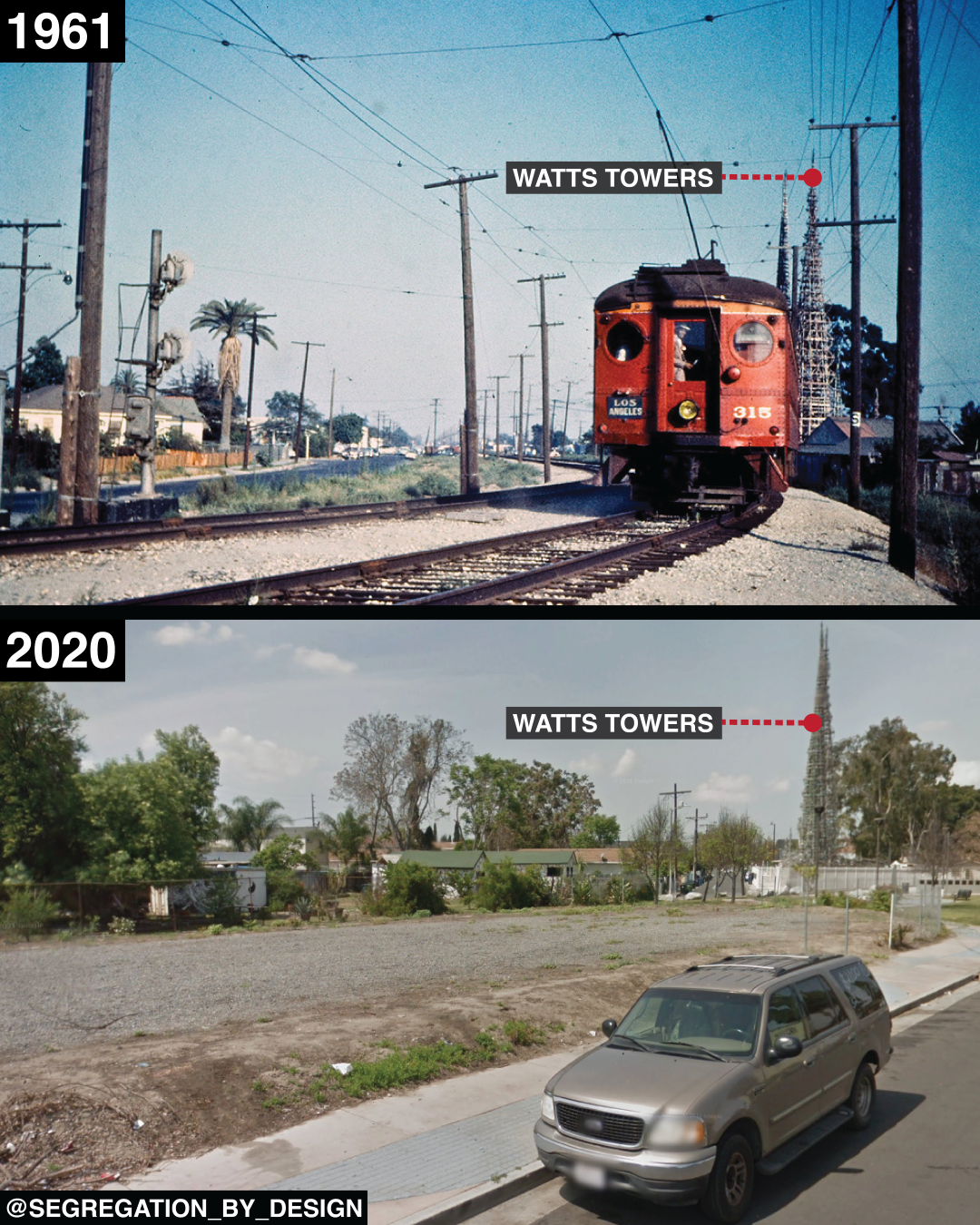LOS ANGELES: TRANSIT
“We had the ‘big red’ that would go out to Pasadena, big red to San Pedro, big red to Long Beach,” remembers famed saxophonist Big Jay McNeely (1927-2018). “They ran so fast, it didn’t take you any time to get there.” Nicknamed for the color scheme of its vehicles, at its height the Pacific Electric was the largest electric rail system in the world, with the iconic “big red cars” covering over 1,100 miles of track. Combined with the “yellow cars” of the Los Angeles Railway (which covered Downtown and central neighborhoods), high-quality public transit was available across the region at large (1).
“For many working class and middle class people, the PE provided opportunities that had previously eluded them,” writes Ryan Reft for PBS SoCal (2). As the city’s population grew over the first half of the 20th century–and grew increasingly diverse, including significant waves of Black, Latino, and Asian immigration to the city–residents relied on the Pacific Electric to access both work and leisure.
“Watts residents like Mary Hernandez used the red cars to commute to her job at Firestone Tire Factory in Florence. But on weekends, Hernandez remembers, ‘we would catch a Red Car and we’d go to the dances there in Los Angeles,’” Reft writes. “Miriam Matthews, the first Black librarian to be hired by LA Public Library, shared memories in 2007 about Santa Monica’s Inkwell, a popular beach destination for LA’s African American community. ‘You would take the red car down and spend a day on the beautiful beach or rent a room if you desired,’ she recalled.” (More on the Inkwell in the previous post.)
Reft continues: “The V line enabled the jazz and blues clubs on Central Avenue to thrive, as the PE drew a diverse clientele from different parts of the city. At a time when racially exclusionary policies prevented blacks from entering clubs on the west side like the Swanee Inn on Westwood Boulevard, Central Avenue became one of the few areas where whites and blacks could mix socially."
By 1963, the entire system was gone, replaced with a haphazard patchwork of private and public bus operators providing significantly reduced and uncoordinated service.
The post-war highway boom had both drained the privately-operated system of all but the lowest-income riders, and poured automobiles onto the sections where the PE ran in mixed traffic, significantly slowing service (this was particularly a problem in Downtown). Even still, “while Los Angeles County's levels of car ownership boomed during these years, many Black and Latino residents found purchasing a car beyond their means,” writes UCLA History Professor Eric Avila in “Popular Culture in the Age of White Flight.” “Public transit continued to represent the best option for getting around the city. Despite questionable conditions and reliability, many Blacks, Latinos, and whites in places like Watts and South Central continued to utilize the PE until its ultimate demise.” (3)
While there are many local factors that led to the dismantling of electric transit in LA (including the conspiratorial actions of automobile and oil companies as fictionalized in the movie Who Framed Roger Rabbit, the sprawling/development-oriented nature of the system, and others), like so many other cities around the US whose systems were dismantled, public and official hostility towards the increasingly diverse city center and close-in neighborhoods during the post-war years caused many to begin viewing public transportation with antipathy. In the 40s and 50s LA officials referred to the big red cars as “wheeled slums” (and General Motors officials referred to them as “mongrel vehicles”)(4).
Incentivized with funding from the 1956 Federal Highway Act, rather than invest in the diverse “inner city” by maintaining the aging electric rail network, the city cut freeways through existing neighborhoods to facilitate growth in the suburbs–suburbs built with racially-restrictive covenants and single-family zoning to ensure only middle class whites had access. Whereas the rail network facilitated diversity through density, the highway network has facilitated segregation through sprawl.
Reft writes: “In the end, P.E.'s denouement, written largely by forces more powerful than it, represented the sunset of multiracial Los Angeles to be replaced by a car-centric future that disaggregated and reorganized the city's populations into ever more racially and ethnically uniform neighborhoods.”
"The demise of the Red and Yellow Car systems had dire consequences for communities such as Watts and Boyle Heights, which became isolated centers of racialized poverty in the subsequent age of the freeway,” Professor Avila concludes.
Since the 90s, the city has slowly been rebuilding its rail network, though aside from two fully-grade separated lines (the B & D Line subways), Metro is unfortunately repeating many of the same operational mistakes PE made in the first place. Namely: lack of fully dedicated rights of way. Because of this, trains are often forced to stop for traffic lights and at intersections, significantly slowing trip times. Moreover, questionable routing decisions have left the system difficult to navigate, often requiring multiple transfers.
That said, in general LA’s transit has significantly improved since its low point in the 60s and 70s. Since the formation of the LACMTA in 1993 through the consolidation of rival agencies, the city has normalized and updated bus routes, improving service and frequency. Given that the majority of today’s riders use the bus network, it is critical to continue improving it. Check out Streetsblog LA for more on the current developments in LA transit.
Endnotes
Ethan N. Elkind. “Railtown: The Fight for the Los Angeles Metro Rail and the Future of the City.” University of California Press, 2014.
Reft, Ryan. “Riding the Big Red Car: Work, Leisure, and Community in Multiethnic LA.” PBS SoCal, 2014. https://www.pbssocal.org/history-society/riding-the-big-red-car-work-leisure-and-community-in-multiethnic-l-a (accessed 1/19/2024).
Avila, Eric. “Popular Culture in the Age of White Flight Fear and Fantasy in Suburban Los Angeles.” University of California Press, 2004
Reft.


